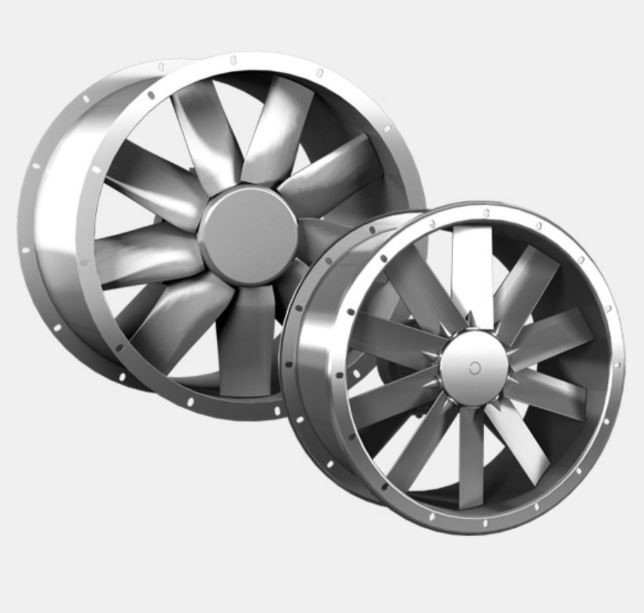
Plenty Global



A centrifugal fan is a mechanical device for moving air or other gases in a direction at an angle to the incoming fluid. Centrifugal fans often contain a ducted housing to direct outgoing air in a specific direction or across a heat sink; such a fan is also called a blower fan, biscuit blower[, or squirrel-cage fan (because it looks like a hamster wheel). These fans increase the speed and volume of an air stream with the rotating impellers.
Centrifugal fans use the kinetic energy of the impellers to increase the volume of the air stream, which in turn moves against the resistance caused by ducts, dampers and other components. Centrifugal fans displace air radially, changing the direction (typically by 90°) of the airflow. They are sturdy, quiet, reliable, and capable of operating over a wide range of conditions.
Centrifugal fans are constant-displacement or constant-volume devices, meaning that, at a constant fan speed, a centrifugal fan moves a relatively constant volume of air rather than a constant mass. This means that the air velocity in a system is fixed even though the mass flow rate through the fan is not.
Centrifugal fans are not positive-displacement devices and centrifugal fans have certain advantages and disadvantages when contrasted with positive-displacement blowers: centrifugal fans are more efficient, whereas positive-displacement blowers may have a lower capital cost.
The centrifugal fan has a drum shape composed of a number of fan blades mounted around a hub. As shown in the animated figure, the hub turns on a driveshaft mounted in bearings in the fan housing. The gas enters from the side of the fan wheel, turns 90 degrees and accelerates due to centrifugal force as it flows over the fan blades and exits the fan housing
ebm-papst centrifugal fans are available with forward and backward-curved blades. The quiet-running centrifugal fans with forward-curved blades are also supplied with a scroll housing. The centrifugal fans with backward-curved blades are designed as freewheel fans and do not require a scroll housing. In the case of centrifugal fans with external rotor motors, the motor is positioned in the impeller, ensuring not just optimum cooling of the motor, but also a particularly compact design. The entire range is available with both AC and GreenTech EC technology. In addition to being particularly energy-saving, the integrated electronics also make it possible to implement any control, monitoring and maintenance functions – for both the smart home and Industry .
The advantages of centrifugal fans from ebm-papst:
The forward curved centrifugal fans are also called as 'squirrel cage' fans because the wheel type used in this fan is of squirrel cage wheel. The impeller has forward blades which are relatively smaller, curved in direction of wheel rotation.
The delicate construction of the impeller, shaft, bearings, and housing of forward curved fans limit its suitability in industrial applications. These fans are ideal for low speed and low pressure applications such as in domestic furnaces, central station units, packaged air conditioning etc.
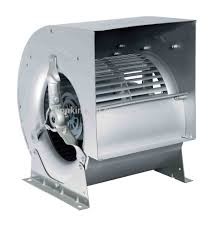
The backward inclined centrifugal fans offer three standard blade types – flat single thickness, curved single thickness and curved airfoil. The blades are generally heavier and larger than forward curved and move away from the direction of wheel rotation. They produce relatively medium to high airflow at static pressures.
These fans produce highest operating speeds and are found to be more efficient than the other types of centrifugal fans. The backward inclined fans are typically used in low pressure, high volume applications such as heating, ventilation and air conditioning systems.
Radial Blade FansRadial blade centrifugal fans also called as paddle wheel fans, consists of an impeller with multiple equally spaced flat blades that are extending perpendicular to the direction of wheel rotation. The wheel is a paddle type wheel which may or may not contain side rims and the blades are comparatively heavier, deeper and narrower than forward and backward inclined blades.
They produce medium to high pressure and moves relatively a higher mass or volume of fluid. Radial blade types are well suited for material handling and in some moderate pressure industrial applications.
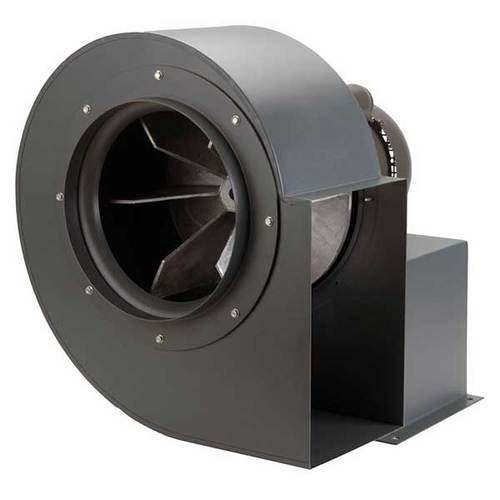
Airfoil blade fans have hollow backward inclined blades that are suitable to handle large volumes of clean air at low to moderate static pressures. These fans produce optimum efficiency and run at greater speed than the backward inclined fans.
As they can handle large volumes of air, these fans are extensively used in forced and induced draft fans that are suitable for broad operating ranges in industrial applications, HVAC systems, air pollution control, drying & filtration, and other industrial processes.
Radial Tip FansThe blades of radial tip centrifugal fans have backward curved configuration but cupped in the direction of the wheel rotation. The velocity produced by the Radial tip fan is same as that of backward inclined wheel to move the given mass or volume of air. These fans have compact design than airfoil and backward curved fans and are ideal for high-volume flow rate applications where the pressure requirement is also relatively high.
Radial tip fans have moderate material handling capabilities but are more efficient than radial blade fans. They are generally used in dust collection systems and general ventilation applications.
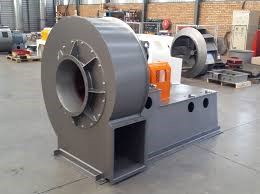
The inline centrifugal fans have rugged construction with backward inclined type wheels enclosed in a tube-axial casing. These are medium duty fans with straight through airflow.
When compared to radial inclined type fans the inline centrifugal fans are less efficient and are used in low pressure air system requirements like heating and ventilating.
Based on the specific requirements of airflow rate, volume, pressure and efficiency, centrifugal fans of various types are designed to serve the needs of diverse industrial applications.
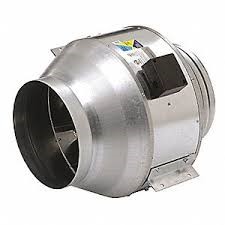

An axial fan is a type of fan that causes gas to flow through it in an axial direction, parallel to the shaft about which the blades rotate. The flow is axial at entry and exit. The fan is designed to produce a pressure difference, and hence force, to cause a flow through the fan. Factors which determine the performance of the fan include the number and shape of the blades. Fans have many applications including in wind tunnels and cooling towers. Design parameters include power, flow rate, pressure rise and efficiency. Axial fans generally comprise fewer blades (two to six) than ducted fans.
Axial Flow Fans or Industrial Axial Fans use a propeller to draw the air into the fan and discharge it in the same axial direction. The most common types of Industrial Axial Fans are: Tube Axial Fans (or Duct Fans), Panel Fans (or Wall Fans), Personnel Coolers and Air Circulators.
The advantages of axial fans
Commercial plate axial extractor fans. One of the most common and economic varieties of fans, plate axial fans are normally mounted on a wall and vent straight outside. Used for kitchens, warehouses, factories, chicken sheds, bitcoin mining fans etc. Here we offer several manufacturers options for comparison. The size offered is the diameter across the blades, the overall size (including the plate) is slightly larger. (See data-sheets.)
A WSK gravity shutter is normally mounted externally. Available in single and three phase versions and most are speed controllable. Not normally used with ducting, for this use a cased axial fan type. All fixings available. Any questions or advice please contact us.
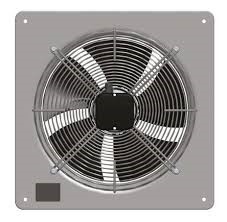
Standard long cased axial units of which there are 80 different models, incorporate integral mounting flanges with industry standard drillings. This feature allows fan removal from in-line duct application with relative ease. The centrally mounted motor is wired to an IP55 protected, duct mounted terminal box on the outside of the fan casing, using a flexible and weatherproof cable

Standard short cased axial units of which there are also 80 different models, incorporate integral mounting flanges with industry standard drillings. The configuration of this fan allows the rear of the platform mounted motor to partially protrude beyond the flange. An external duct mounted terminal box is available on request. This configuration particularly suits end-of-duct or O.E.M. applications or applications with limited space.
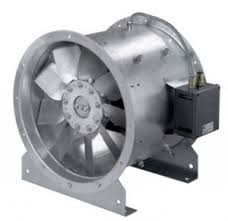
The range of high power axial fans with adjustable blades cover a wide capacity range due to their large variation possibilities with hub relation, number of blades and blade angle.
The allowed temperatures of the conveyed mediums are from -20°C up to +40°C as a standard. Special motors for higher temperatures up to 100°C on request.
